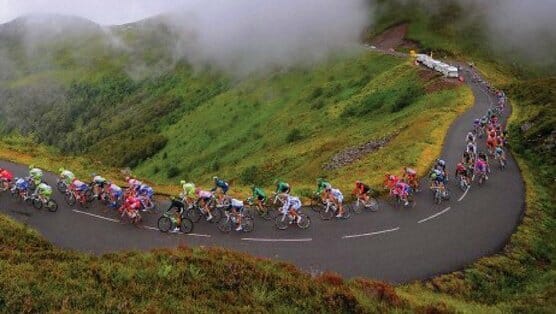Lanterne Rouge: The Last Man in the Tour de France by Max Leonard
Bringing Up the Rear

The peloton: It sounds a classical beast, a chimeric maelstrom of short, fanged feet and raging lungs, gnashing teeth and sawing limbs, leaving the broken dreams and machines of the finest men in its wake.
The peloton is the great pack of huddled cyclists whipping around whatever godforsaken corner of race course these animate skeletons have the greatest blessing and curse of propelling themselves through. It is the dangerous, many-limbed, many-wheeled core of the race.
 Away from the dramatic ball lay the escape artists, the smaller, swifter packs battling amongst each other to propel one of their own, their chosen one, to victory in the race. And well behind the pushing, heaving mass are the stragglers, the world class made seemingly pedestrian, by virtue of injury, technical difficulty, force majeur, calamity or simply being out of their depth. And finally, behind all of these, there is the lanterne rouge.
Away from the dramatic ball lay the escape artists, the smaller, swifter packs battling amongst each other to propel one of their own, their chosen one, to victory in the race. And well behind the pushing, heaving mass are the stragglers, the world class made seemingly pedestrian, by virtue of injury, technical difficulty, force majeur, calamity or simply being out of their depth. And finally, behind all of these, there is the lanterne rouge.
The lanterne rouge—named, most likely, for the red lights hung from the back of a train’s final car—is the traditional, albeit unofficial, honorific bestowed upon the last man in the Tour de France. He is, by the cruelest definition, the Tour’s loser, although scores of riders will have dropped out before him. He is also, by any definition, a world class champion and veritable demigod compared to pretty much everyone you know (unless your coterie includes numerous professional road cyclists). His sheer survival is impressive when you consider the blood and mountains and cruel heat he has overcome, to say nothing of his own mind and damned failing legs.
-

-

-

-

-

-

-

-

-

-

-

-

-

-

-

-

-

-

-

-

-

-

-

-

-

-

-

-

-

-

-

-

-

-

-

-

-

-

-

-








































